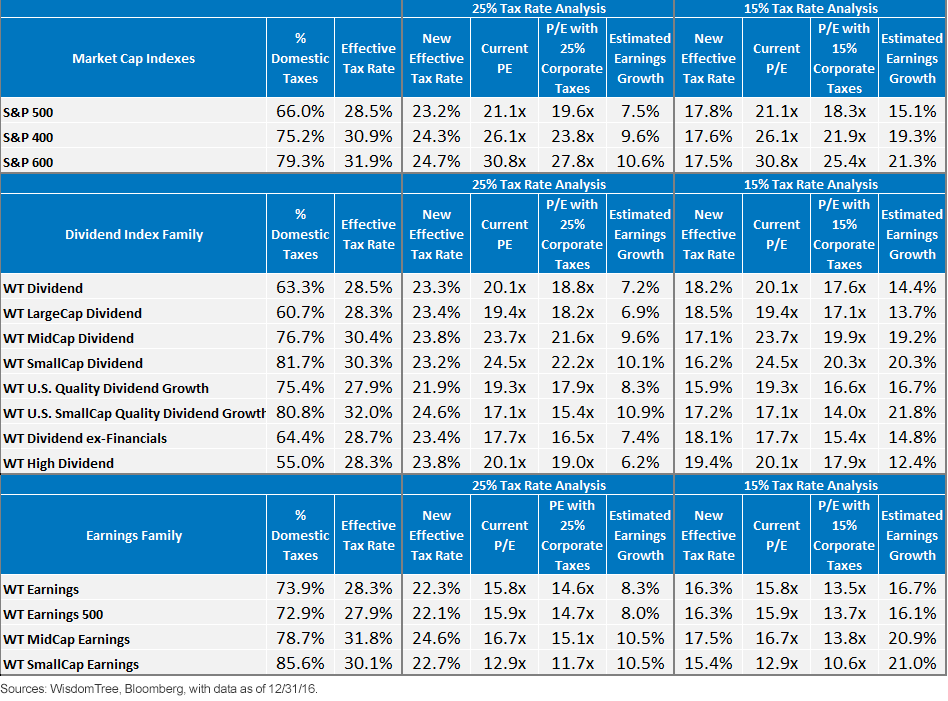Impact of Potential Tax Reform



Based on the initial market response to Trump’s victory, lowering tax rates looks to us like the most important factor driving the market.
Equity markets, of course, like it when taxes are cut. It naturally means more after-tax earnings that can be reinvested or distributed to shareholders—and, importantly, an improvement in valuation ratios that many think look extended under present circumstances.
We published an initial sensitivity analysis to look at how various assumptions on tax rates might impact the earnings growth and ultimate market valuations across a market cap-weighted index set of the S&P 500, S&P 400 and S&P 600—and across the sectors in those indexes. We have updated our original analysis to also include domestic WisdomTree Indexes; we also have updated our initial model for estimating the potential tax benefit that shows new results for the cap-weighted index family.1
To summarize the results, a simple model shows the following: the more earnings (and taxes paid) that come from the U.S., the greater the earnings growth would be from a tax cut, because by and large, the companies with revenue across the world already have lower effective tax rates.
Indexes with a higher percentage of profitable companies—and thus companies that pay more U.S. taxes—potentially stand to benefit more than indexes with more unprofitable companies.
The indexes with more revenue from the U.S. tend to be mid- and small-cap indexes.
The WisdomTree Earnings Index family—which only includes profitable companies and weights companies based on profits—shows a potential improvement in earnings that is higher than the WisdomTree Dividend Index family.
Why?
We have examined the potential gains from lower tax rates across sectors, and the two sectors that stand out the least as beneficiaries are the Energy sector and Real Estate sector.
Companies in the Real Estate and Energy sectors tend to make up a bigger percentage of the dividend Indexes than the earnings Indexes.
Real estate investment trusts (REITs) already pay little taxes at their trust level if they distribute at least 90% of their income.2 They thus also do not benefit as much from new policies.
A number of energy companies, particularly large-cap energy companies, have a global revenue base and pay more taxes overseas. They stand to benefit less from U.S. tax rate cuts and thus would see less meaningful increases in earnings and improvements in valuations. They also have depressed earnings today, so, based on the changes we modeled, they may not see much improvement from that side either.
Looking across the WisdomTree Index family below, we’d highlight the following:
• Showing how important the WisdomTree earnings-weighted approach can be for lowering valuations and how much these can be improved with a reduction in corporate taxes—if Trump gets his desired 15% tax rate approved—a simple model shows potential gains in reducing price-to-earnings (P/E) ratios from a touch under 16 for a broad market earnings-weighted index or a large-cap earnings index to just 13.5 times earnings.
o We also show the calculations at a reduction to 25%—a more conservative assumption, and even here the broad market multiples, on an earnings-weighted basis, would fall below 15 times, a fairly reasonable starting valuation.
• An example of indexes that benefited more: small-cap indexes with more revenue from the U.S. stand to benefit at greatest amounts across the WisdomTree Dividend and Earnings Index families. In contrast to the S&P 600, which would still have a P/E ratio above 25 under a 15% corporate tax rate scenario, we’d point out the WisdomTree SmallCap Dividend Index with a P/E ratio of 20.3, the WisdomTree U.S. SmallCap Quality Dividend Growth Index at 14.0 and the WisdomTree SmallCap Earnings Index at 10.6 times are reasonably valued small-cap indexes.

Conclusion
The analysis presented herein will be an ongoing work in progress for us. As more details about Trump’s policies become clear, we plan to update this scenario analysis with better models to help clients understand where the market valuations might be affected most by tax reform.
1Our precise calculations estimate an effective tax rate for each index and a new method for calculating this starting effective tax rate when companies have losses resulting in a lower starting effective tax rate and thus a smaller improvement in earnings growth with new tax policy scenarios.

Jeremy Schwartz has served as our Global Chief Investment Officer since November 2021 and leads WisdomTree’s investment strategy team in the construction of WisdomTree’s equity Indexes, quantitative active strategies and multi-asset Model Portfolios. Jeremy joined WisdomTree in May 2005 as a Senior Analyst, adding Deputy Director of Research to his responsibilities in February 2007. He served as Director of Research from October 2008 to October 2018 and as Global Head of Research from November 2018 to November 2021. Before joining WisdomTree, he was a head research assistant for Professor Jeremy Siegel and, in 2022, became his co-author on the sixth edition of the book Stocks for the Long Run. Jeremy is also co-author of the Financial Analysts Journal paper “What Happened to the Original Stocks in the S&P 500?” He received his B.S. in economics from The Wharton School of the University of Pennsylvania and hosts the Wharton Business Radio program Behind the Markets on SiriusXM 132. Jeremy is a member of the CFA Society of Philadelphia.


